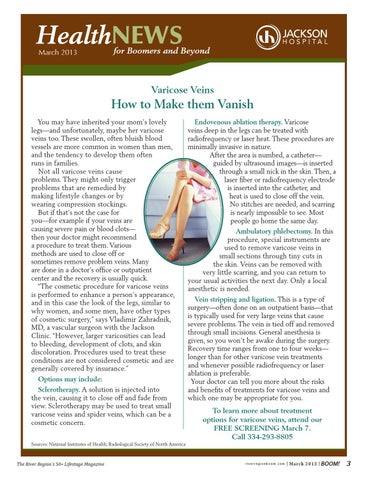HealthNEWS March 2013
for Boomers and Beyond
Varicose Veins
How to Make them Vanish You may have inherited your mom’s lovely legs—and unfortunately, maybe her varicose veins too. These swollen, often bluish blood vessels are more common in women than men, and the tendency to develop them often runs in families. Not all varicose veins cause problems. They might only trigger problems that are remedied by making lifestyle changes or by wearing compression stockings. But if that’s not the case for you—for example if your veins are causing severe pain or blood clots— then your doctor might recommend a procedure to treat them. Various methods are used to close off or sometimes remove problem veins. Many are done in a doctor’s office or outpatient center and the recovery is usually quick. “The cosmetic procedure for varicose veins is performed to enhance a person’s appearance, and in this case the look of the legs, similar to why women, and some men, have other types of cosmetic surgery,” says Vladimir Zahradnik, MD, a vascular surgeon with the Jackson Clinic. “However, larger varicosities can lead to bleeding, development of clots, and skin discoloration. Procedures used to treat these conditions are not considered cosmetic and are generally covered by insurance.” Options may include: Sclerotherapy. A solution is injected into the vein, causing it to close off and fade from view. Sclerotherapy may be used to treat small varicose veins and spider veins, which can be a cosmetic concern.
Endovenous ablation therapy. Varicose veins deep in the legs can be treated with radiofrequency or laser heat. These procedures are minimally invasive in nature. After the area is numbed, a catheter— guided by ultrasound images—is inserted through a small nick in the skin. Then, a laser fiber or radiofrequency electrode is inserted into the catheter, and heat is used to close off the vein. No stitches are needed, and scarring is nearly impossible to see. Most people go home the same day. Ambulatory phlebectomy. In this procedure, special instruments are used to remove varicose veins in small sections through tiny cuts in the skin. Veins can be removed with very little scarring, and you can return to your usual activities the next day. Only a local anesthetic is needed. Vein stripping and ligation. This is a type of surgery—often done on an outpatient basis—that is typically used for very large veins that cause severe problems. The vein is tied off and removed through small incisions. General anesthesia is given, so you won’t be awake during the surgery. Recovery time ranges from one to four weeks— longer than for other varicose vein treatments and whenever possible radiofrequency or laser ablation is preferable. Your doctor can tell you more about the risks and benefits of treatments for varicose veins and which one may be appropriate for you.
To learn more about treatment options for varicose veins, attend our FREE SCREENING March 7. Call 334-293-8805
Sources: National Institutes of Health; Radiological Society of North America
The River Region’s 50+ Lifestage Magazine
r i ve r reg i o n b o o m . co m
March 2013
BOOM!
3
